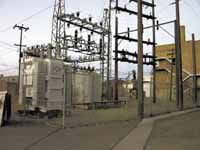| The downtown substation, the oldest in the Price City system, shows the most problems of the three substations. With the age of equipment, repairs and replacement will be difficult. The level of PCBs is above the level accepted by the EPA and the fence is not grounded. |
A study by KEE Engineering evaluated the condition and capacity of power substations owned by Price city.
Karl Kraync, a representative of the engineering firm, presented the results of the study to Price councilmembers at a regular city meeting on April 12.
The study focused on the three substations which regulate power in Price city.
The downtown or central substation is located on the block north of Main Street and east of Carbon Avenue.
The courthouse substation is on the block east of Price City Hall and north of Main.
The high school substation is located north of the baseball fields at Carbon High.
No substation is operating at full capacity.
The downtown substation has 1,000 KVA to spare, about 30 percent of capacity.
The courthouse substation has 3,800 KVA to spare, about 34 percent of capacity.
At the time of the study, the high school substation had 3,900 KVA to spare or about 40 percent of capacity.
But with the addition of east Price to the city’s electrical grid, that load is expected to increase by about 2,500 KVA, leaving 15 percent to 20 percent spare capacity on the substation.
One area of immediate concern related to electrocution risk at the substations.
“All substation fencing should be grounded, especially around gating areas. Right now there is no grounding at all on the downtown substation fence. That’s the oldest substation in the system. That’s something that should be fixed immediately,” said Kraync.
Another issue related to the downtown and courthouse substation concerns fencing connected to the substation fence.
“Any time you make a connection to a substation fence, you provide the potential to electrocute anybody that comes in contact with that fence in certain instances,” explained Kraync.
There is one connection at the courthouse fence, a partially repaired connection at the high school substation and another short connection at the downtown substation.
Kraync explained that there are three types of electrocution potential.
First, there’s touch potential when you can touch two pieces of metal within the substation that are not properly grounded.
Second, there’s step potential while walking across the ground in a poorly grounded substation. Third, electrocution can occur by touching equipment in a fault condition.
“Under fault, lightning or any of those types of instance, the whole system become energized, including the grounding. For instance if you have a 1,000-amp fault in the substation, which is a fairly minor fault, that will put about 5,000 volts of potential into the system. So the entire grounding system is raised 5,000 volts,” said Kraync
If any portion of the system is not grounded, such as a fence or any of the equipment, that portion has a potential for electrocution.
Kraync also expressed concern over the age of the downtown substation. As the oldest substation in the system, replacement and availability of any of the major components in the substation would be difficult. Most substations have been upgraded to 12,470-volt equipment. The downtown substation has not and still runs at 4,160 volts.
“If the transformer in that substation were to fail, there is not one readily accessible unless you happen to find one, whereas a 12,470 transformer would be much easier to come by,” said Kraync.
Mayor Joe Piccolo indicated that the city had considered getting intermediary transformers which could be installed in the downtown substation to bring it up to the equivalent of 12,470. This solution would be a work-around until the city could upgrade th entire substation.
Kraync suggested that the city could probably save money by leaving the system intact and upgrading the main transformer first and transferring portions of the system to the new equipment as the budget allowed.
The downtown substation also has high levels of polychlorinated biphenyl, or PCB, a compound known to cause developmental issues with unborn children and health problems at all ages.
Older electrical equipment used PCBs as part of the insulation. The transformer, the voltage regulator and some of the switch gear at the downtown station are above 50 parts per million, a level at which repairs become more expensive, or impossible due to exposure of workers and repair equipment to the compounds containing PCBs.
The study recognized need for improvement was in the area of system documentation.
“There’s a lack of information flow between UP&L, the service provider, and Price City. That information is used for everything, for repairs, for emergencies, for any problems with the system,” said Kraync.
The study also found some minor liabilities within the system, including leaking equipment and minor repairs or upgrades that would improve safety and service at each of the substations.

